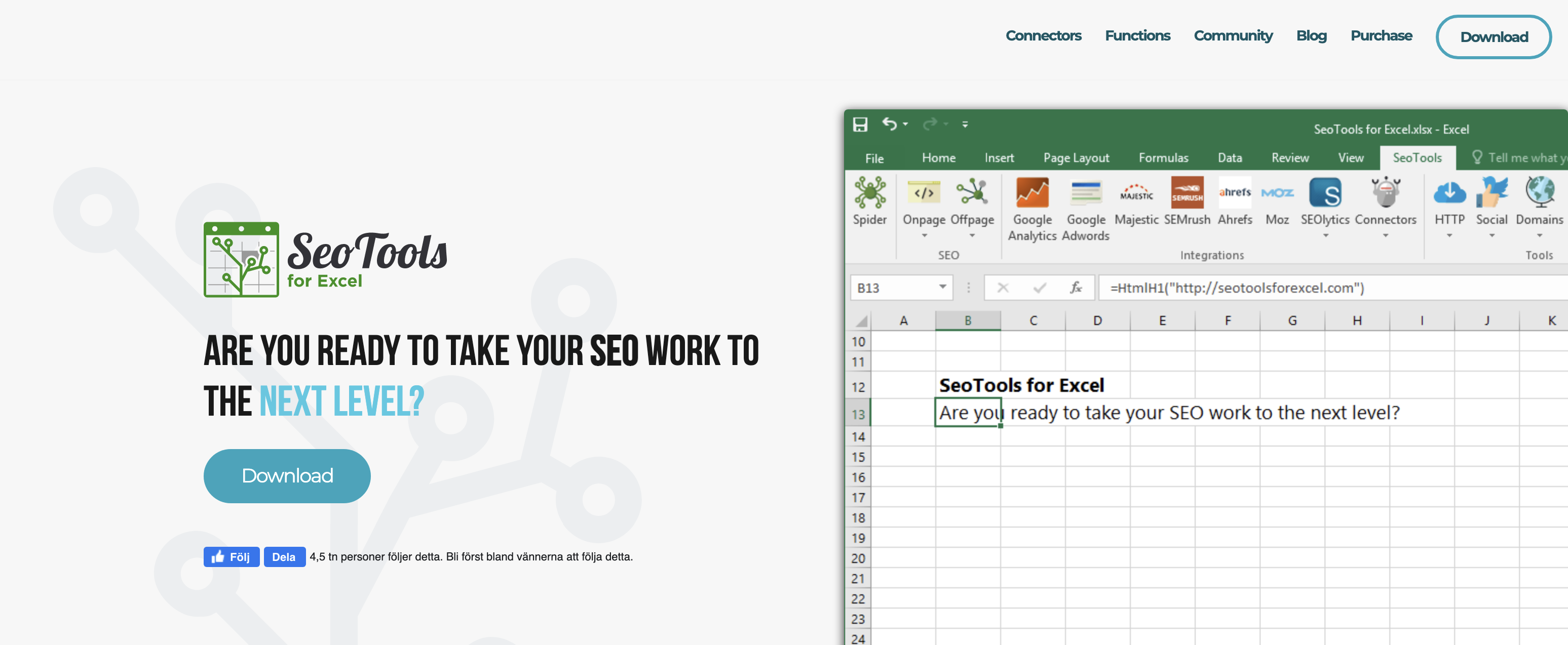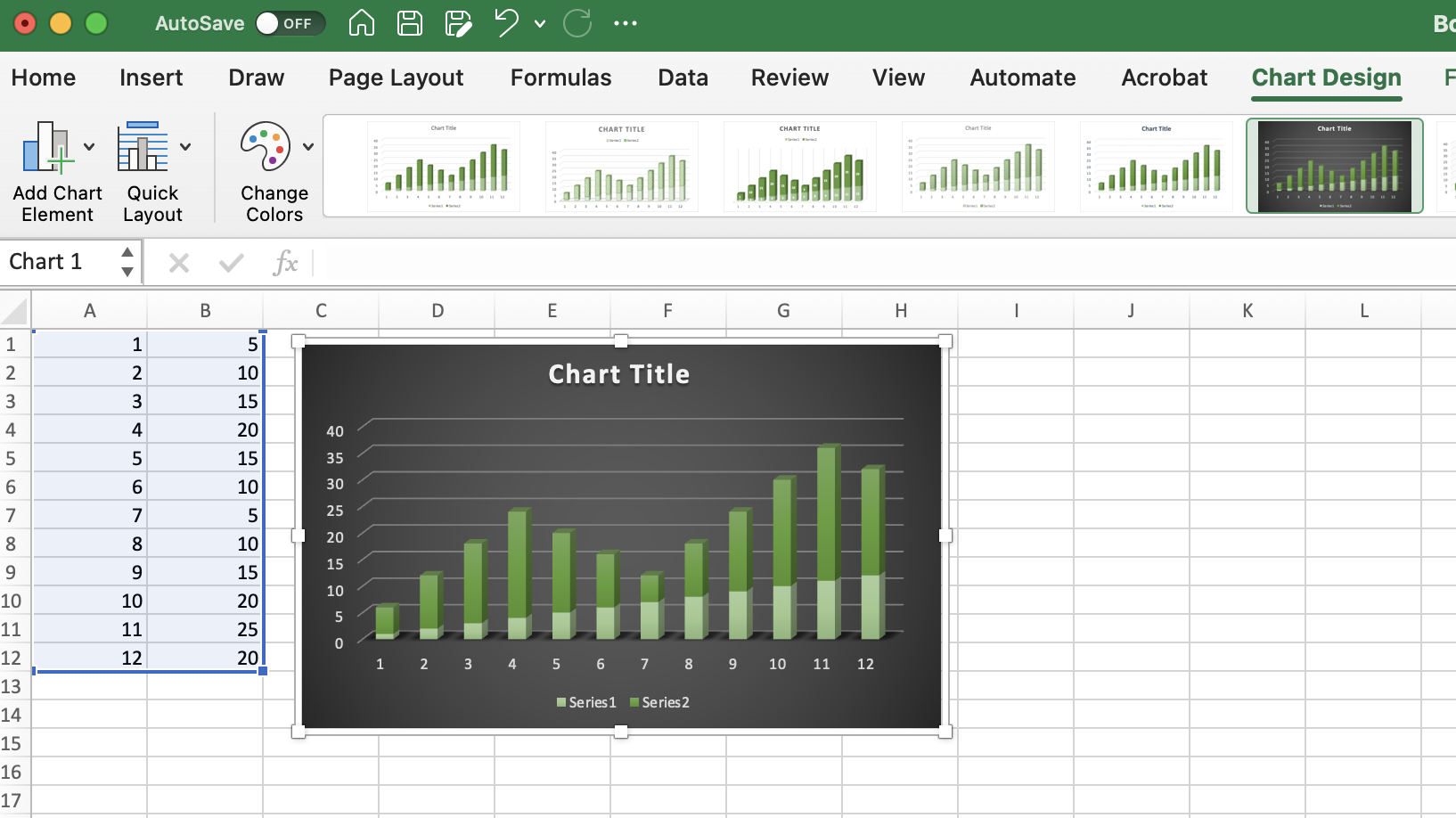SEO
7 Essential Tips & Tricks You Might Not Know

It may not look like one of the fancy, paid SEO tools you’re used to logging into, but Excel remains one of the most versatile and powerful tools in an SEO professional’s toolbox.
You can use Excel to track and analyze key metrics such as rankings, website traffic, and backlinks.
Use it to create and update meta tags, track and analyze competitors’ SEO strategies and performance, build automated reports, and take care of many of the data tasks you’ll encounter every day.
Combine your Excel knowledge with Python, Tableau, R, and other tools, and there is nothing you can’t do.
If you’ve never worked with data before, you’ll find Excel has a bit of a learning curve, but you can use it right from the start. And it’s flexible enough to scale and grow as your site grows.
Why Excel For SEO Tasks?
While many paid tools can help you do the same tasks, Excel is a fantastic option to enhance, combine, or replace those tools.
- It’s affordable and comes with a range of tools you already use.
- There are a ton of resources and courses to help you learn.
- Easily handles large amounts of data.
- Sorting and de-duplicating – a feature often missing when you need it.
- Create and manage databases with simple formulas.
- Data ports easily to other tools and is available for other tasks.
- Pivot tables and smart charts.
1. Combine Multiple Data Sources
You will often find yourself having to merge data from multiple sources.
This is intuitive and quick in Tableau, Python, or R, but you can do the same in Excel using Power Query.
There are a few steps to this process, but it’s not as complicated as you might think – even if you are new to working with data or Excel.
Power Query has automated and simplified tasks that required a lot of time and skill.
And it is probably THE best Excel feature for business and SEO professionals.
Seem a bit daunting? Don’t worry. There are several courses and tutorials on YouTube to get you started.
What It’s Good For:
- Building reports.
- Analytics and sales data.
- Combining data sources to identify opportunities and gain insights.
2. Data Cleaning
Much of your time is lost simply preparing data for analysis. It doesn’t have to be that way.
Large lists are often larger than they need to be. Finding and manually removing all the duplicates, however, can be a serious pain.
Excel can do this instantly for you. Simply go to the “Data” tab and click “Remove Duplicates.”
Unwanted spaces and blank lines tend to cause havoc with many tasks, formulas, and statistics.
Excel will remove them for you simply by going to Edit > Find > Go To. Select “Special,” “Blanks,” and tell Excel how it should handle them.
“Convert text to columns” can be a lifesaver, especially if you’ve received data where the addresses or names are all in the same cell or you need to extract domains from email addresses.
Go to Data > Text to Columns. Then, indicate what to use for Delimiters (comma or space) and preview the results. When you’re ready, click “Next,” choose a destination, and click “Finish.”
When To Use It:
- Data analysis.
- Data processing.
- Processing and cleaning lead databases.
- Working with any data.
3. Power Excel With Add-On Tools
Some of the more complex tasks, such as crawling, require a bit of coding knowledge.
If you don’t have that in your skillset, however, there are tools you can download, integrate with other tools, and add on.
 Screenshot from SEOTools, January 2023.
Screenshot from SEOTools, January 2023.SEOTools offers off and on-page SEO tools, integrations, connectors, spiders, and several other tools that make it easy to customize your Excel and create custom projects.
SEOGadget brings the power of Moz, Grepwords, and Majestic to Excel.
Analysis ToolPak is for serious data analysis. This add-on improves and automates in-depth statistics, perfect for forecasting, trending, regression analysis, and more complex data analysis tasks you might otherwise perform in R or Python.
When To Use It:
- Reporting.
- Regular data analysis.
- Presentations.
- Integrating and coordinating with other teams.
4. Infographics And Charts
Data is useless if you can’t understand it.
In fact, data visualization and storytelling are likely some of the most important skills you can have. This is where tools like Power Query and PivotTables come in.
Built right into Excel, pivot tables are the other valuable tools you have for this purpose.
However, instead of just creating a straight pivot table and a related chart, save yourself some steps by creating a master “template” first that you can then replicate as needed and adjust to suit your needs.
 Screenshot from Excel, January 2023.
Screenshot from Excel, January 2023.In many instances, however, you will need to work with dates or segments of the data. For that, you’ll want to enter splicers and timelines.
- To splice data into segments: Select the pivot table and go to PivotTable Tools > Analyze > Filter > Insert Slicer. Then, simply input how you would like to segment the content (e.g., by product or topic).
- To utilize timelines: Click the pivot table’s tools option, go to Analyze > Filter > Insert Timeline. Once there, you can choose what you’d like to use, style it, add captions, and more.
If you’ve never used Excel’s PivotTables before, a short tutorial will have you on your way to analyzing data in no time.
Still want a little more? Make your reports, social media, and updates even better by upping your data visualization game with add-ons like People Graph.
When To Use It:
- Reporting.
- Daily updates.
- Surface data analysis.
- Team collaboration and integration.
5. Automate Common Tasks With Macros
SEO, particularly agency SEO, is full of repetitive tasks like weekly reporting that consume much of your time. Excel’s macros are the answer. And they’re really easy to use.
Under the “View” tab, click “Macros” and “Record Macro.”
 Screenshot from Excel, January 2023.
Screenshot from Excel, January 2023.Fill out the details.
The macro is now recording. So, simply walk through the steps that you’d like to automate. And when you’re done, go back to the ribbon and stop the recording.
When you’re ready to run the automation, go to the macro button in the ribbon, click “View Macros,” and select the desired macro from the list.
If you have some macros that you use more often than others, you can add them to the Quick Access Toolbar.
When To Use It:
- Sorting.
- Calculations.
- Reformatting data.
- Setting up new site documents or new pages for reports.
6. Easily Import Feeds And Data Into Excel
If you use Google Alerts or publish frequently, automatically importing feeds into Excel can be a huge time saver.
To start, simply grab the RSS feed address. (Or, create an alert for Google Alerts and have them delivered as an RSS feed.)
 Screenshot from Google Sheets, January 2023.
Screenshot from Google Sheets, January 2023.Then, go to Google Sheets and use the IMPORTFEED function to bring the updates straight into a spreadsheet.
Alternatively, you can add the information to separate columns.
 Screenshot from Google Sheets, January 2023.
Screenshot from Google Sheets, January 2023.From here, you can regularly download and import the data into Excel, combine it with other related data, or integrate it into your custom dashboards.
If you need something a little more automatic, use Google Apps Script or one of the add-ons available to automate the process.
Want a little more data behind your reports? You can scrape and import Google Search Results into Excel, too.
7. Backlink Analysis
To analyze backlinks with Excel, collect backlink data with tools such as Ahrefs, Majestic, or Google Search Console.
Then, import it into Excel and use it to analyze your backlinks in a number of ways:
- Who links to you: Use Excel’s sorting and filtering tools to filter the data and use the IF function: IF(logic, true_value,[false_value]) to sort and identify domains linking to you.
- What do people link to: Sort and filter to see the anchor text used most often for your backlinks (using frequency/count).
- When did people link to you: Organize the data by date to see how old your links are and when most of your backlinks were acquired.
Find trends or patterns in your backlink profiles with pivot tables, groups, charts, and graphs by combining your backlink and sales or conversion data.
Highlight specific data based on certain conditions with conditional formatting. This makes it easy to spot backlinks from high-authority websites or backlinks with specific anchor text.
Summary
Many people overlook Excel either because they think it’s too basic to be of much use. Or it looks too intimidating or daunting to learn.
But those of us who use it understand just how powerful it can be and the unlimited possibilities it provides.
Hopefully, these tips will help you craft better strategies, find new opportunities, and tell your story with better reports and dashboards.
Featured Image: Paulo Bobita/Search Engine Journal
SEO
Google On Hyphens In Domain Names

Google’s John Mueller answered a question on Reddit about why people don’t use hyphens with domains and if there was something to be concerned about that they were missing.
Domain Names With Hyphens For SEO
I’ve been working online for 25 years and I remember when using hyphens in domains was something that affiliates did for SEO when Google was still influenced by keywords in the domain, URL, and basically keywords anywhere on the webpage. It wasn’t something that everyone did, it was mainly something that was popular with some affiliate marketers.
Another reason for choosing domain names with keywords in them was that site visitors tended to convert at a higher rate because the keywords essentially prequalified the site visitor. I know from experience how useful two-keyword domains (and one word domain names) are for conversions, as long as they didn’t have hyphens in them.
A consideration that caused hyphenated domain names to fall out of favor is that they have an untrustworthy appearance and that can work against conversion rates because trustworthiness is an important factor for conversions.
Lastly, hyphenated domain names look tacky. Why go with tacky when a brandable domain is easier for building trust and conversions?
Domain Name Question Asked On Reddit
This is the question asked on Reddit:
“Why don’t people use a lot of domains with hyphens? Is there something concerning about it? I understand when you tell it out loud people make miss hyphen in search.”
And this is Mueller’s response:
“It used to be that domain names with a lot of hyphens were considered (by users? or by SEOs assuming users would? it’s been a while) to be less serious – since they could imply that you weren’t able to get the domain name with fewer hyphens. Nowadays there are a lot of top-level-domains so it’s less of a thing.
My main recommendation is to pick something for the long run (assuming that’s what you’re aiming for), and not to be overly keyword focused (because life is too short to box yourself into a corner – make good things, course-correct over time, don’t let a domain-name limit what you do online). The web is full of awkward, keyword-focused short-lived low-effort takes made for SEO — make something truly awesome that people will ask for by name. If that takes a hyphen in the name – go for it.”
Pick A Domain Name That Can Grow
Mueller is right about picking a domain name that won’t lock your site into one topic. When a site grows in popularity the natural growth path is to expand the range of topics the site coves. But that’s hard to do when the domain is locked into one rigid keyword phrase. That’s one of the downsides of picking a “Best + keyword + reviews” domain, too. Those domains can’t grow bigger and look tacky, too.
That’s why I’ve always recommended brandable domains that are memorable and encourage trust in some way.
Read the post on Reddit:
Read Mueller’s response here.
Featured Image by Shutterstock/Benny Marty
SEO
Reddit Post Ranks On Google In 5 Minutes

Google’s Danny Sullivan disputed the assertions made in a Reddit discussion that Google is showing a preference for Reddit in the search results. But a Redditor’s example proves that it’s possible for a Reddit post to rank in the top ten of the search results within minutes and to actually improve rankings to position #2 a week later.
Discussion About Google Showing Preference To Reddit
A Redditor (gronetwork) complained that Google is sending so many visitors to Reddit that the server is struggling with the load and shared an example that proved that it can only take minutes for a Reddit post to rank in the top ten.
That post was part of a 79 post Reddit thread where many in the r/SEO subreddit were complaining about Google allegedly giving too much preference to Reddit over legit sites.
The person who did the test (gronetwork) wrote:
“…The website is already cracking (server down, double posts, comments not showing) because there are too many visitors.
…It only takes few minutes (you can test it) for a post on Reddit to appear in the top ten results of Google with keywords related to the post’s title… (while I have to wait months for an article on my site to be referenced). Do the math, the whole world is going to spam here. The loop is completed.”
Reddit Post Ranked Within Minutes
Another Redditor asked if they had tested if it takes “a few minutes” to rank in the top ten and gronetwork answered that they had tested it with a post titled, Google SGE Review.
gronetwork posted:
“Yes, I have created for example a post named “Google SGE Review” previously. After less than 5 minutes it was ranked 8th for Google SGE Review (no quotes). Just after Washingtonpost.com, 6 authoritative SEO websites and Google.com’s overview page for SGE (Search Generative Experience). It is ranked third for SGE Review.”
It’s true, not only does that specific post (Google SGE Review) rank in the top 10, the post started out in position 8 and it actually improved ranking, currently listed beneath the number one result for the search query “SGE Review”.
Screenshot Of Reddit Post That Ranked Within Minutes
Anecdotes Versus Anecdotes
Okay, the above is just one anecdote. But it’s a heck of an anecdote because it proves that it’s possible for a Reddit post to rank within minutes and get stuck in the top of the search results over other possibly more authoritative websites.
hankschrader79 shared that Reddit posts outrank Toyota Tacoma forums for a phrase related to mods for that truck.
Google’s Danny Sullivan responded to that post and the entire discussion to dispute that Reddit is not always prioritized over other forums.
Danny wrote:
“Reddit is not always prioritized over other forums. [super vhs to mac adapter] I did this week, it goes Apple Support Community, MacRumors Forum and further down, there’s Reddit. I also did [kumo cloud not working setup 5ghz] recently (it’s a nightmare) and it was the Netgear community, the SmartThings Community, GreenBuildingAdvisor before Reddit. Related to that was [disable 5g airport] which has Apple Support Community above Reddit. [how to open an 8 track tape] — really, it was the YouTube videos that helped me most, but it’s the Tapeheads community that comes before Reddit.
In your example for [toyota tacoma], I don’t even get Reddit in the top results. I get Toyota, Car & Driver, Wikipedia, Toyota again, three YouTube videos from different creators (not Toyota), Edmunds, a Top Stories unit. No Reddit, which doesn’t really support the notion of always wanting to drive traffic just to Reddit.
If I guess at the more specific query you might have done, maybe [overland mods for toyota tacoma], I get a YouTube video first, then Reddit, then Tacoma World at third — not near the bottom. So yes, Reddit is higher for that query — but it’s not first. It’s also not always first. And sometimes, it’s not even showing at all.”
hankschrader79 conceded that they were generalizing when they wrote that Google always prioritized Reddit. But they also insisted that that didn’t diminish what they said is a fact that Google’s “prioritization” forum content has benefitted Reddit more than actual forums.
Why Is The Reddit Post Ranked So High?
It’s possible that Google “tested” that Reddit post in position 8 within minutes and that user interaction signals indicated to Google’s algorithms that users prefer to see that Reddit post. If that’s the case then it’s not a matter of Google showing preference to Reddit post but rather it’s users that are showing the preference and the algorithm is responding to those preferences.
Nevertheless, an argument can be made that user preferences for Reddit can be a manifestation of Familiarity Bias. Familiarity Bias is when people show a preference for things that are familiar to them. If a person is familiar with a brand because of all the advertising they were exposed to then they may show a bias for the brand products over unfamiliar brands.
Users who are familiar with Reddit may choose Reddit because they don’t know the other sites in the search results or because they have a bias that Google ranks spammy and optimized websites and feel safer reading Reddit.
Google may be picking up on those user interaction signals that indicate a preference and satisfaction with the Reddit results but those results may simply be biases and not an indication that Reddit is trustworthy and authoritative.
Is Reddit Benefiting From A Self-Reinforcing Feedback Loop?
It may very well be that Google’s decision to prioritize user generated content may have started a self-reinforcing pattern that draws users in to Reddit through the search results and because the answers seem plausible those users start to prefer Reddit results. When they’re exposed to more Reddit posts their familiarity bias kicks in and they start to show a preference for Reddit. So what could be happening is that the users and Google’s algorithm are creating a self-reinforcing feedback loop.
Is it possible that Google’s decision to show more user generated content has kicked off a cycle where more users are exposed to Reddit which then feeds back into Google’s algorithm which in turn increases Reddit visibility, regardless of lack of expertise and authoritativeness?
Featured Image by Shutterstock/Kues
SEO
WordPress Releases A Performance Plugin For “Near-Instant Load Times”

WordPress released an official plugin that adds support for a cutting edge technology called speculative loading that can help boost site performance and improve the user experience for site visitors.
Speculative Loading
Rendering means constructing the entire webpage so that it instantly displays (rendering). When your browser downloads the HTML, images, and other resources and puts it together into a webpage, that’s rendering. Prerendering is putting that webpage together (rendering it) in the background.
What this plugin does is to enable the browser to prerender the entire webpage that a user might navigate to next. The plugin does that by anticipating which webpage the user might navigate to based on where they are hovering.
Chrome lists a preference for only prerendering when there is an at least 80% probability of a user navigating to another webpage. The official Chrome support page for prerendering explains:
“Pages should only be prerendered when there is a high probability the page will be loaded by the user. This is why the Chrome address bar prerendering options only happen when there is such a high probability (greater than 80% of the time).
There is also a caveat in that same developer page that prerendering may not happen based on user settings, memory usage and other scenarios (more details below about how analytics handles prerendering).
The Speculative Loading API solves a problem that previous solutions could not because in the past they were simply prefetching resources like JavaScript and CSS but not actually prerendering the entire webpage.
The official WordPress announcement explains it like this:
Introducing the Speculation Rules API
The Speculation Rules API is a new web API that solves the above problems. It allows defining rules to dynamically prefetch and/or prerender URLs of certain structure based on user interaction, in JSON syntax—or in other words, speculatively preload those URLs before the navigation. This API can be used, for example, to prerender any links on a page whenever the user hovers over them.”
The official WordPress page about this new functionality describes it:
“The Speculation Rules API is a new web API… It allows defining rules to dynamically prefetch and/or prerender URLs of certain structure based on user interaction, in JSON syntax—or in other words, speculatively preload those URLs before the navigation.
This API can be used, for example, to prerender any links on a page whenever the user hovers over them. Also, with the Speculation Rules API, “prerender” actually means to prerender the entire page, including running JavaScript. This can lead to near-instant load times once the user clicks on the link as the page would have most likely already been loaded in its entirety. However that is only one of the possible configurations.”
The new WordPress plugin adds support for the Speculation Rules API. The Mozilla developer pages, a great resource for HTML technical understanding describes it like this:
“The Speculation Rules API is designed to improve performance for future navigations. It targets document URLs rather than specific resource files, and so makes sense for multi-page applications (MPAs) rather than single-page applications (SPAs).
The Speculation Rules API provides an alternative to the widely-available <link rel=”prefetch”> feature and is designed to supersede the Chrome-only deprecated <link rel=”prerender”> feature. It provides many improvements over these technologies, along with a more expressive, configurable syntax for specifying which documents should be prefetched or prerendered.”
See also: Are Websites Getting Faster? New Data Reveals Mixed Results
Performance Lab Plugin
The new plugin was developed by the official WordPress performance team which occasionally rolls out new plugins for users to test ahead of possible inclusion into the actual WordPress core. So it’s a good opportunity to be first to try out new performance technologies.
The new WordPress plugin is by default set to prerender “WordPress frontend URLs” which are pages, posts, and archive pages. How it works can be fine-tuned under the settings:
Settings > Reading > Speculative Loading
Browser Compatibility
The Speculative API is supported by Chrome 108 however the specific rules used by the new plugin require Chrome 121 or higher. Chrome 121 was released in early 2024.
Browsers that do not support will simply ignore the plugin and will have no effect on the user experience.
Check out the new Speculative Loading WordPress plugin developed by the official core WordPress performance team.
How Analytics Handles Prerendering
A WordPress developer commented with a question asking how Analytics would handle prerendering and someone else answered that it’s up to the Analytics provider to detect a prerender and not count it as a page load or site visit.
Fortunately both Google Analytics and Google Publisher Tags (GPT) both are able to handle prerenders. The Chrome developers support page has a note about how analytics handles prerendering:
“Google Analytics handles prerender by delaying until activation by default as of September 2023, and Google Publisher Tag (GPT) made a similar change to delay triggering advertisements until activation as of November 2023.”
Possible Conflict With Ad Blocker Extensions
There are a couple things to be aware of about this plugin, aside from the fact that it’s an experimental feature that requires Chrome 121 or higher.
A comment by a WordPress plugin developer that this feature may not work with browsers that are using the uBlock Origin ad blocking browser extension.
Download the plugin:
Speculative Loading Plugin by the WordPress Performance Team
Read the announcement at WordPress
Speculative Loading in WordPress
See also: WordPress, Wix & Squarespace Show Best CWV Rate Of Improvement
-

 WORDPRESS7 days ago
WORDPRESS7 days ago10 WordPress Influencers to Follow in 2024 – WordPress.com News
-

 SEARCHENGINES7 days ago
SEARCHENGINES7 days agoGoogle Image Search Adds Pixel Level Object Segmentation Animation
-

 MARKETING7 days ago
MARKETING7 days agoFeeling Stuck: What to Do When You Don’t Know What to Do
-

 PPC5 days ago
PPC5 days agoA History of Google AdWords and Google Ads: Revolutionizing Digital Advertising & Marketing Since 2000
-

 SEARCHENGINES6 days ago
SEARCHENGINES6 days agoMore Google March 2024 Core Update Ranking Volatility
-

 PPC6 days ago
PPC6 days agoCompetitor Monitoring: 7 ways to keep watch on the competition
-

 WORDPRESS6 days ago
WORDPRESS6 days agoThrive Architect vs Divi vs Elementor
-

 PPC6 days ago
PPC6 days ago31 Ready-to-Go Mother’s Day Messages for Social Media, Email, & More















You must be logged in to post a comment Login